With this decade’s leaps in technology that has become affordable and easy to acquire, many consumers are left with loads of computers and other electronic goods that require some level of maintenance. No longer must the public rely on professionals to fix broken or damaged circuit boards. Much like hardware, soldering irons have improved as well, under which a multitude of brands currently sell them online. Below are reviews showcasing the ten best soldering irons you’ll find anywhere around. They include kits with even more tools to help you finish soldering jobs quickly. The Buyer’s Guide further down will allow you to add context to the choices provided, followed by two of the best kits mentioned in the Conclusion.
1. Vastar Full Set 60W 110V Soldering Iron – Best Soldering Iron For Circuit Boards (Editor’s Choice)
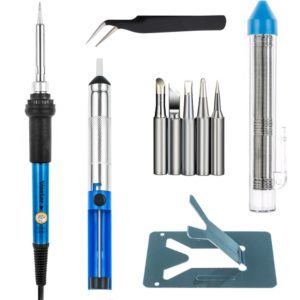
The Vastar Full Set is a soldering iron kit that’s built with all the safety features you can think of. If you’re looking for a product that has strong tips that won’t melt after hundreds of uses, it rarely gets better than this. Check Price
The build is proof of its professional grade, and can be used with solder that contains no lead materials. Changing the temperature is easy. Just turn the small yellow and white dial on the side near the handle. If you feel it warming to the touch, don’t panic. It can get a little hot after being on for a while, but not to the point of affecting your work. Overall, the Vastar is a good kit for anyone to have around when working on a circuit board.
Pros
- The plastic tip on the device is resistant to heat and won’t melt
- Safe to use with solder that contains no lead
- Has the option to control the intensity of heat that’s applied
Cons
- The handle can get hot quickly on the highest settings
2. POWER PROBE Butane Soldering Kit (PPSK) – Best High Temp Soldering Iron (People’s Choice)
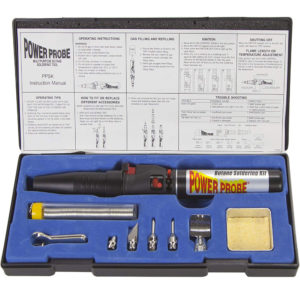
The Power Probe Butane Iron is bundled with a kit that multiple secondary tools for soldering. All parts of the iron itself are very durable. If you mistakenly dropped it, nothing would get damaged. And because the body’s constructed so well, you’ll probably have it for a long time without needing a replacement set. Check Price
As for the accessories, it comes with a small carrying case made of hardened plastic, tips, and foam padding in the case’s interior. The exterior is waterproof, so you can take it out in wet weather an not have anything from inside exposed to moisture. Recommended for users appreciate quality and short heating times.
Pros
- Built with precision, parts not cheaply made
- Numerous accessories are included with the soldering iron
- The iron becomes hot in less than a minute
Cons
- There’s no way to tell when gas needs to be refilled
3. OMorc Desoldering Wick – Best Desoldering Iron
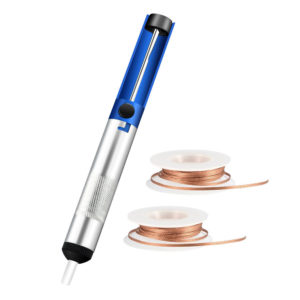
The OMorc Desoldering Wick isn’t a soldering iron but can help immensely with the soldering process when paired with one. As the name describes it, the tool desolders and cleans boards by sucking up old residue from the pins. Check Price
You can use it prior to or during the soldering, and you’ll notice the boards come out much cleaner when completed. No longer will you have to solder on top of metal that already exists. Just turn the wick on, press the upper pin down, and allow all debris to travel into the container that’s inside the handle. Again, you can use the OMorc with any iron of your choice, so consider this if you’re kit doesn’t include a wick in the product’s description.
Pros
- Very fast heating time
- Comes with a set of tweezers for removing old solder
- The built in vacuum can eliminate additional solder residue from circuit boards during and prior to work commences
Cons
- The temperature control knobs is situated in an annoying position, may make work slightly more difficult
4. Master Appliance Ultratorch UT-100SiK – Best Wireless Soldering Iron
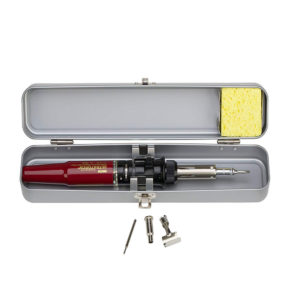
The Master Appliance Ultratorch is another gas-powered soldering iron that has a pocket-sized carrying pouch. You could easily fit it inside your pocket, or take it with you and not have it get in your way. There’s no electricity to rely on and the iron relies solely on butane for fuel. Check Price
As for how long it will last before a refill it needed, the runtime is about two hours. Although it’s not a common occurrence, you may experience times where the ignitor can only be activated manually. But it’s nothing that should keep you away from the Ultratorch, particularly if you need an iron that’s wireless.
Pros
- The soldering iron doesn’t rely on electricity for power (wireless)
- Heated by butane fuel; easy to find if more needed
- Run time approximated to two hours or more
- Comes with a pocket-sized carrying case
Cons
- If the igniter fails to light the butane, the iron must be heated manually
5. Tabiger Soldering Iron Kit Electronics – Best Soldering Iron For Durability
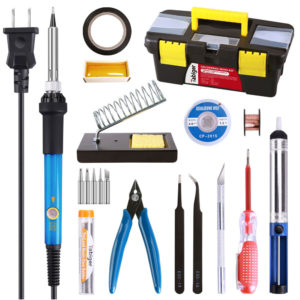
The Tabiger Soldering Iron is the ultimate in terms of added accessories. Everything is provided in one package, or box. The carrying case resembles a small toolbox and provides the tools with comparable protection. Check Price
A wick is also featured with the set, so you won’t need to look for one if the Tabiger is chosen. The iron is also high in quality, but a little lighter around the handle. As a result, fatigue isn’t out of the question, especially if you have large hands. If you think this is a non-issue, then settling on the Tabiger would be fine by all means.
Pros
- There are five soldering points included with the set
- Sold with a plastic carrying case that will fit everything inside, with a little room to spare
- Easy to clean (and features to items necessary to do it)
Cons
- The handle is very lightweight and may need to be supported by something heavier, especially for heavy users
6. ANBES Soldering Iron Kit (1) – Best Soldering Iron For Small Circuit Boards
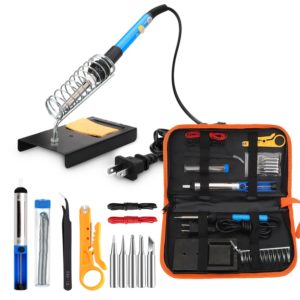
The Anbes Soldering Iron Kit also features a desoldering wick, but that’s not the only thing under its belt. Five different pins, along with a dock for the iron also come with the pack. As for the case, it’s nylon. Check Price
You won’t want to get it wet but it should keep your gear from getting dirty or rusted. But the selling point is the iron, outfitted with many different temperature settings for all sorts of solder. Great for anyone that’s working with circuit boards that are very small.
Pros
- The desoldering tool will reduce work time in half (when compared to the length it would take without it)
- Has a wide range of temperature settings
- Small tips allow for the iron to fit into tight corners without burning anything
Cons
- Although the kit contains lots of different tools, many of them are low in quality and may get damaged over time
7. Anbes Soldering Iron Kit (2) – Best Soldering Iron For Ease of Handling
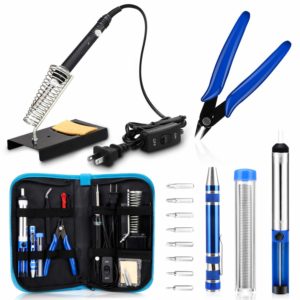
The Second Anbes kit is a lot like the other product from the same company but has some minor differences. It comes with tweezers, a wick, an best of all, an eight-bit screwdriver for any tiny screws you come across while working. Check Price
The iron’s handle won’t get hot to the touch and has a bumpy surface that can prevent slipping. If you hand sweat profusely when you’re soldering, then this Anbes kit will take away the hassles that are synonymous with soldering for long periods of time.
Pros
- The handle is resistant to slips and made for sweaty palms
- The wire cutters will shave through measure solder fast
- During transport, the case is small enough to be place inside backpacks or mini duffel bags
Cons
- Heat up time is significantly slower than its competitors
8. Tabiger Soldering Iron Kit 60W 110V – Best Soldering Iron For Temperature Control
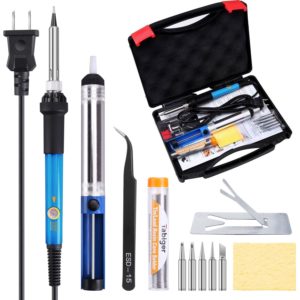
The Tabiger Soldering Iron Kit, like the other that was shown previously, also has a plastic carrying case. It’s shaped differently than the first one and is a little smaller. And while there are fewer items included with the pack than the other, all the essentials remain featured. Check Price
The tips are hardened well and won’t melt fast. And a handle little light indicator can be used when you’re soldering in small or hard to see corners. For those who wear glasses, this one attribute may be the deciding factor on the product.
Pros
- The carrying case is waterproof
- Very dense tip that doesn’t chip away or melt easily
- A light indicator informs the user when the device is hot
- Easy to adjust temperature control
Cons
- Easy to change the temperature on the iron without realizing it
9. Anbes Soldering Iron Kit 60W – Best Soldering Iron For Accessories

The third Anbes Soldering Iron Kit has an extra accessory that isn’t available on any of the other product shown thus far. A multimeter tool is given, which can be used to measure currents from your iron’s power source. Check Price
If preferred, you can also use it to gauge resistance on your circuit board, a great way to ensure that no electric current is present as you solder. The iron has few flaws and will hold up during touch jobs without melting. You might have to reset the temperature in some instances, but nothing too out of the ordinary.
Pros
- A multimeter tool for gauge DC and AC currents is added, along with many other useful tools
- The desoldering pump quickly cleans away debris from boards of all sorts
- The case has a fabric hook at the top to make carrying (with other tools) a bit easier
Cons
- At times, the soldering iron’s heat seems to rise and fall while in operation
10. Magento’s Superb 14 Pieces Set – Best Soldering Iron For Comfort
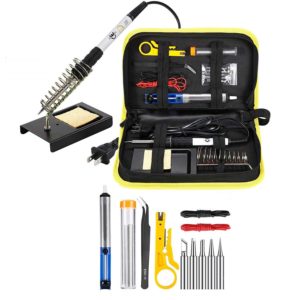
The Magento Superb Set is the right tool for small welding and soldering. The advantage is how easy it is to hold the tool, no matter if you’re restoring jewelry or operating on a large computer. A minor but convenient plus is the mount, or stand. Check Price
When you place the iron inside the coils, nothing will shake or risk toppling over. And temperatures are almost accurate to the decimal. The biggest flaw is the solder that comes with the product. For those with experience in soldering, you’ve probably used better in quality before. Replace it with something better, and you’ll have a kit that’s commensurate any high-quality soldering iron.
Pros
- Comfortable to hold for long periods without handle getting too hot
- The stand for securing the iron doesn’t wobble and tip over easily when stationary
- The temperature settings are accurate and doesn’t fluctuate when the device had been turned on for a long time
Cons
- Replacing the solder that’s included with the product is suggested
Buyer’s Guide
Knowing how to solder was once a skill reserved for technicians, mostly those who worked with computers of some sort. Things are much different now, and soldering courses have been commonplace in school curriculum the world over. Still, that doesn’t mean that the majority could end up with a poor quality soldering iron, the kind that breaks before it’s even used. The information below will help you minimize your choices above, and you should have a general idea on what to look for at the end.
What to Use Soldering Irons For
Think of a soldering iron as welding, but done on a much smaller scale. The process involves melting long pieces of metal until they harden the surface being worked on. Soldering does take some skill, although the basics can be learned very quickly. Most people need soldering irons to repair circuit boards, of which can be found on anything from common household items to high-end computers. If you want to restore your dusty old PC or laptop, the tool will likely come in handy. Or maybe you want to want to create your own panels from scratch! Whatever the case, knowing how to solder and having one in possession at home is a great way to fix or design electronics instead of buying new equipment every time something breaks.
Video Tutorial: How to Solder
Power Choices
Soldering irons are varied and can have different purposes, but those commonly sold online can be classified by the power source. Some are run from gas or AC power. DC adapters may also be used, so be sure to look at the product’s description if you don’t need an AC cord. The advantages of wired irons are good power and heat regulation. With an AC and DC powered model, you won’t have to worry about refueling the tank or how hot the tip will get.
Butane soldering irons take typically take butane fluid for power, which could be provided by the manufacturer in a small amount or something that you’ll have to purchase individually. The ability to solder anywhere without a wire is the most obvious benefit, but there’s also heat. Some soldering irons that rely on fire can get hot and maintain a high temperature that melts the solder immediately upon contact. But which should you choose? It’s left up to your discretion, but factor in the setting to which you plan on working, especially if you plan on soldering in more than one location.
Accessories
You won’t often find a soldering iron that’s sold without other accessories. In fact, most of them will feature kits with enough items to refrain from additional purchases. The typical soldering iron kit will contain tweezers for correcting mistakes and picking up old solder, a vacuum to keep the work area clean, and a carrying case. There will likely be more equipment but don’t settle on the accessories alone. Your kit should be judged first by the iron itself, whereby a product with the best attachments can be useless if the main piece isn’t functional. If you notice poor quality parts that are added with a pack, don’t fret over it too much. Those can always be replaced. In short, the iron is what counts the most.
Temperature Control and Settings
Soldering irons old often had only one temperature setting that couldn’t be changed. Those days are over, thankfully. With today’s brands, you can alternate the heat from just above room temperature to hundreds of degrees. Finding a product with good temp regulation could be a dealbreaker, particularly if you anticipate working with a variety of different solder materials. Some solder is better for certain temperatures. For example, brazing copper will likely require temperatures that are much higher than ordinary solder usually requires. If you want to be able to achieve both very hot and mild options in one iron alone, then look at the products with the most settings for the feature. Brands that run on electricity (and mentioned earlier) often have more options but that doesn’t rule out gas-powered derivatives either.
Quality of Parts and Accessories
The quality and durability of accessories that are included with soldering kits can change with each brand. Some manufacturers do a good job and provide more than enough items to go along with the iron, while others may feature cheaply made goods that aren’t useful. Pictures alone may not be enough to differentiate between what’s good and what isn’t. The best way to tell if you’re getting good accessories is to so simply look at what others have said about them. You could go to the links provided in the reviews, or take note of any references made to the pieces above. Nevertheless, try not to get a headache from judging the quality of the additions; they can be upgraded easily.
Comfort
This is often overlooked aspect to buying a soldering iron. How comfortable does it feel to hold? Will the heat become too hot for me to handle the device? There’s no single answer due to the amount of soldering iron products sold. But if you will be working with the tool for hours at a time, check to see if the handle is insulated. Most are, but some can still get hot once the iron had been left on for a while. However, it won’t be enough to cause injury to your hand. You should be able to work with a gun that’s at its hottest point, but you should watch your hands at all times. For anyone that’s safety oriented, you will definitely want to get protective gloves, more so if the person using the iron is a beginner.
FAQ
Is a 30-watt soldering iron powerful enough?
A 30-watt soldering iron is ideal for tinkering with small electronics. At 30-watts, a soldering iron is unlikely to damage sensitive circuits and wires.
Most 30-watt soldering irons achieve a set temperature through a thermal equilibrium. However, some have an adjustable temperature range.
When a soldering iron is used, the heat is transferred directly to the joint. Then, the soldering iron’s temperature drops. If allowed to reheat, the iron will once again achieve its preset temperature.
It’s worth noting that low-watt soldering irons lose energy during every application. Users must wait for their 30-watt soldering iron to reheat after each usage. If you’re in a rush or need to solder numerous joints, a 30-watt iron may not be the best choice. Nevertheless, the slow, controlled power of a 30-watt soldering iron is a good match for beginners.
Is a 40-watt soldering iron powerful enough?
A 40-watt soldering iron offers enough power for small electronics jobs. Keep in mind that more watts do not translate to higher temperatures. A 40-watt soldering iron simply offers more power. As such, a 40-watt soldering iron is slightly faster and more efficient than a 30-watt soldering iron.
How hot is a 25-watt soldering iron?
Most 25-watt soldering irons can reach a temperature of 750 degrees. More often than not, people assume that low wattage soldering irons can only deliver low temperatures. However, soldering irons need to reach a temperature of 370 degrees to melt solder. In fact, most soldering iron tips can reach temperatures higher than 700 degrees.
With that said, it is essential to use a low temperature when first working with solder. If you start small and work your way up, you can avoid damaging materials.
How hot is a 60-watt soldering iron?
Most 60-watt soldering irons can heat to approximately 900 degrees. With that said, most 60-watt soldering irons feature adjustable temperature controls. What’s more, temperature limits vary depending on the manufacturer. With that said, most 60-watt soldering irons range from 400 to 900 degrees.
Which is better: a soldering iron or gun?
Both soldering irons and soldering guns have their roles. A soldering irons features a rounded handle and a heated wand. Soldering irons are small, lightweight, and straightforward. They are ideal for beginners and individuals working on small electronics. Most soldering irons range between 15 and 60 watts. These heat up to temperatures around 700 degrees.
On the other hand, soldering guns are larger pistol-shaped devices with plenty of power. They are well-suited for extensive soldering jobs and professional soldering stations. While they are bigger and more cumbersome than soldering irons, soldering guns are still flexible and easy to use. With that said, most soldering guns offer at least 100 watts of power.
It’s best to consider your personal experience, goals, and budget before settling on one or the other. Both soldering irons and soldering guns are useful tools.
Can I solder aluminum?
Yes! You can totally solder aluminum. With that said, soldering aluminum is very difficult. That’s because aluminum forms aluminum oxide when it is exposed to oxygen. You must remove the aluminum oxide by scrubbing the surface of the aluminum with a steel brush.
Once the aluminum has been cleaned, you must douse it with an appropriate flux. After prepping the aluminum, you must quickly move on to the soldering process. If you’re too slow, aluminum oxide will reform on the surface of the aluminum. When this happens, the solder will no longer stick to the surface of the aluminum. As such, you will be unable to solder.
Aluminum soldering is not a task for beginners.
What metal cannot be soldered?
Stainless steel, high-alloy steel, iron, and aluminum are all very challenging metals to solder. It is only possible to solder these metals if they are plated in a suitable metal and flux.
These metals cannot be soldered. They oxidize when heated to high temperatures.
What wattage soldering iron do I need?
Soldering irons are available in a range of powers. Low-powered soldering irons are available in 15 to 25 watts. Meanwhile, more heavy-duty options range from 30 to 60 watts. If you’re working with small electronics, a soldering iron between 15 and 25 watts is ideal. For more significant projects, high wattage soldering irons or soldering guns work better. If you intend to use your soldering iron modestly, opt for an iron that offers 25 to 35 watts of power.
Determine what you want to solder before selecting a soldering iron. If you are working with small wires and circuit boards, then a low-watt soldering iron will do just fine. You will need to increase the wattage of your soldering iron depending on the extent of your project.
What is the ideal soldering temperature?
Most solders melt at temperatures between 360 and 370 degrees Fahrenheit. With that said, the tip of a soldering gun needs to be hotter than that if it is going to melt the solder in a reasonable amount of time. You may also need more or less heat depending on the size of the joint you wish to solder.
Keep in mind that there are several different types of solder. Each solder has a specific melting temperature. A solder’s melting temperature is determined by its alloy composition.
Since soldering temperature requirements vary, it’s important to understand how to find the best soldering temperature. To do this, adjust your soldering iron to the lowest possible temperature. Gradually increase the heat until solder begins to melt. If you’re new to soldering, you’ll want to melt the solder low and slow. Low temperatures prevent you from burning the rosin or sensitive parts of a circuit board.
Professional solderers use high temperatures. However, must novice solderers are comfortable soldering between 600 and 700 degrees. If you are using a soldering iron with a set temperature, you will not be able to adjust the heat.
How do you clean a soldering iron?
Clean your soldering iron regularly to improve its longevity. Without regular cleanings, a soldering iron will develop buildup, stains, and residue.
If you are cleaning your iron directly after a soldering session, allow it to cool completely. This may take as long as 30 minutes. Use a damp soldering sponge to wipe off an any old solder, debris, or oxidation.
If there is remaining buildup, use a piece of moist steel wool to scrape away stubborn residue. Steel wool is slightly abrasive. It will enable you to clean the tip of your soldering iron without scratching it.
You may also clean the tip of your soldering iron by wiping it down with a metal cleaner that contains flux and solder. If that doesn’t work, rubbing alcohol or acetone might do the trick.
Keep in mind that soldering tips need to be replaced after considerable use. You can extend the life of your soldering iron by using high-quality solder and cleaning the tip after every use.
You can avoid premature damage to your soldering tip by soldering at a low temperature. This will prevent the solder from burning up and sticking to the soldering tip.
At what temperature does 50/50 solder melt?
Tin and lead 50/50 solder is an all-purpose solder that is 50% tin and 50% lead. According to Canfield Metals, the approximate melting temperature of 50/50 solder is between 361 and 421 degrees.
At what temperature does 60/40 solder melt?
The approximate melting temperature of 60/40 solder is 370 degrees. It’s worth noting that 60/40 solder has the lowest melting point out of all of the tin-lead solders. With that said, you need to heat your soldering iron to 650 to properly melt 60/40 solder. As always, start at a low temperature and work your way up.
How do you maintain a soldering tip?
You must clean and tin the tip of your soldering iron after every soldering session. Use a moist sponge and steel wool to scrape away buildup, stains, and rust. Then, apply a thin layer of solder. This is called tinning. It prevents the tip from oxidizing.
Most experts recommend that you clean and tin your soldering tips after every session. An uncleaned tip will not transfer heat nor stick to solder. After a considerable amount of use, your soldering tips will also need to be replaced.
A well-maintained soldering tip should be silvery and shiny.
Why does my soldering iron tip turn black?
Soldering iron tips are prone to oxidation. When exposed to air, the soldering iron tip may become black or brown. Dark stains are the result of the raw metals being exposed to high temperatures and air.
You can prevent these stains by tinning the tip of your soldering iron after each soldering session. You can also remove the stains with a metal cleaner. Or else, you can remove oxidation using a soldering sponge and steel wool.
It is important to tackle black and brown buildup. An oxidized tip does not transfer heat as well as a clean tinned tip. What’s more, solder will not stick to an oxidized iron. As such, it is essential to remove stains and build up immediately after each soldering session.
What is the difference between welding and soldering?
People often confuse welding and soldering. While both processes result in the joining of two metal parts, there are some key differences. Soldering is the process of creating a metal joint to connect two separate pieces of metal. While the joined objects are heated, they are not melted.
During welding, two metals are also bonded together. During the welding process, the metals that are joined together are melted. What’s more, additional joint material is melted. The combination of fused metals creates a very strong joint.
During the soldering process, a handheld soldering iron or gun is used to soften solder. Usually, the solder is heated to no more than 800 degrees. On the other hand, welding requires the use of a powerful torch. Welding torches heat up to well over 2,000 degrees. As such, welding requires much more training and safety precautions than soldering.
Conclusion
Are you set on which soldering iron brand you want to take home from the reviews in the list? If you’re not, there’s still good news. Two of the products are guaranteed to work well for anyone, from expert assemblers to the newbie that wants to bring life to their computer’s aging hardware. The Vastar Full Set and Power Probe Butane Soldering Kits contain everything you’ll need to get started, including great temperature control and handy extras for the job. With that being said, don’t view the other brands negatively. They are also exceptional, all but making it certain that the tool you end up with will be used for years to come.
Are cheap soldering irons any good?
Weller make exellent soldering irons and this one is one of there cheaper ones.
Features of Weller WLC100:
- Power: 5W to 40W
- Power supply: 120V/60Hz
- Temperature Range: 900⁰F
Table of Contents
- Weller WLC100 User Manual
- Pros & Cons of Weller WLC100
- Pros
- Cons
- Video Guide: How To Use Weller WLC100
Weller WLC100 User Manual
Having problem? Download Weller WLC100 40-Watt Soldering Station instructions. Download
Pros & Cons of Weller WLC100
Pros
- Easy-to-Adjust Variable Power Controls
- Quality, lightweight pencil iron
- Includes a Weller certified ST3 iron-plated copper tip
- Tested and meets independent safety standards
Cons
- Poor arrangement of tip securing set screw
Video Guide: How To Use Weller WLC100

